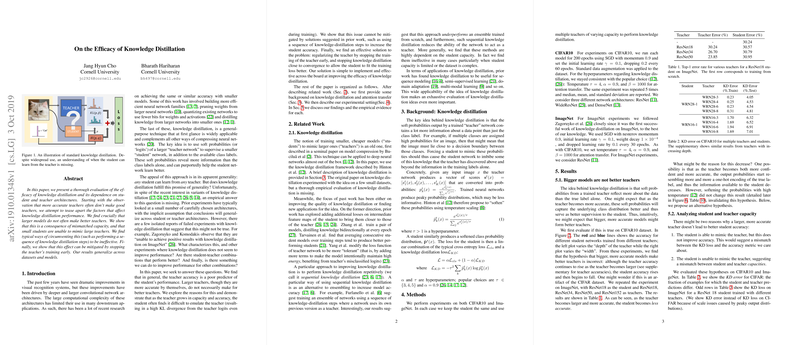Analyzing the Impact of Knowledge Distillation on Neural Network Performance
The paper titled "On the Efficacy of Knowledge Distillation" offers a comprehensive evaluation of knowledge distillation (KD), a technique often utilized for transferring knowledge from larger "teacher" neural networks to smaller "student" networks. The analysis rigorously examines various factors influencing the effectiveness of KD, shedding light on common misconceptions and proposing novel improvements.
Key Findings and Methodology
The authors present a critical insight: the mere accuracy of a teacher model does not equate to effective knowledge distillation. In several experiments conducted on CIFAR10 and ImageNet datasets, larger and more accurate teachers often failed to improve the student model's performance. This counterintuitive result is attributed to a mismatch in the capacity between teacher and student models, where a small student struggles to replicate the complex decision boundaries of a large teacher. The analysis is supported by a detailed breakdown of training and error metrics across multiple model architectures, including ResNet and WideResNet, with varying depth and width.
The paper challenges the efficacy of sequential knowledge distillation as a potential solution. Sequentially distilling knowledge by progressively smaller models resolves little when there is a significant gap in the model capacities. The results from CIFAR10 confirm that such sequential strategies underperform compared to direct training strategies for student models, largely due to high correlation among students of similar architectures.
Proposed Solutions and Results
To mitigate capacity mismatch, a novel approach involves early-stopping the training of the teacher model. This regularization technique prevents the teacher from overfitting and enforces a simpler hypothesis space, more accessible to the student model. Empirical results indicate an improvement in student performance across all tested configurations on both CIFAR10 and ImageNet when this early-stopping strategy is employed. For instance, early-stopped teachers consistently provide better student results than fully-trained teachers, as demonstrated with models like ResNet and DenseNet.
The paper also explores various hyperparameters for KD, such as temperature scaling, and confirms the robustness of early-stopped teachers across diverse student-teacher settings. Furthermore, the implications extend to transfer learning scenarios, with distilled models performing favorably when fine-tuned on datasets like Places365.
Implications and Future Directions
This work underscores the significance of considering model capacity and training choices, rather than solely focusing on accuracy, when curating teacher models for KD. The authors propose early-stopping as an efficient method to align the student's capacity with the teacher's distilled knowledge. This approach simplifies architecture searches and reduces computational costs associated with full teacher training.
Looking forward, the research suggests examining further nuances in KD strategies, particularly in understanding the interplay between teacher complexity and student learning potential. Future explorations could delve into adaptive distillation methods, dynamic capacity adjustments, or hybrid distillation-optimization techniques.
In conclusion, this paper delivers a critical re-evaluation of knowledge distillation's assumptions, offering practical insights and methodologies to enhance the training of student models, ultimately advancing the field of model compression and efficient neural network deployment.
